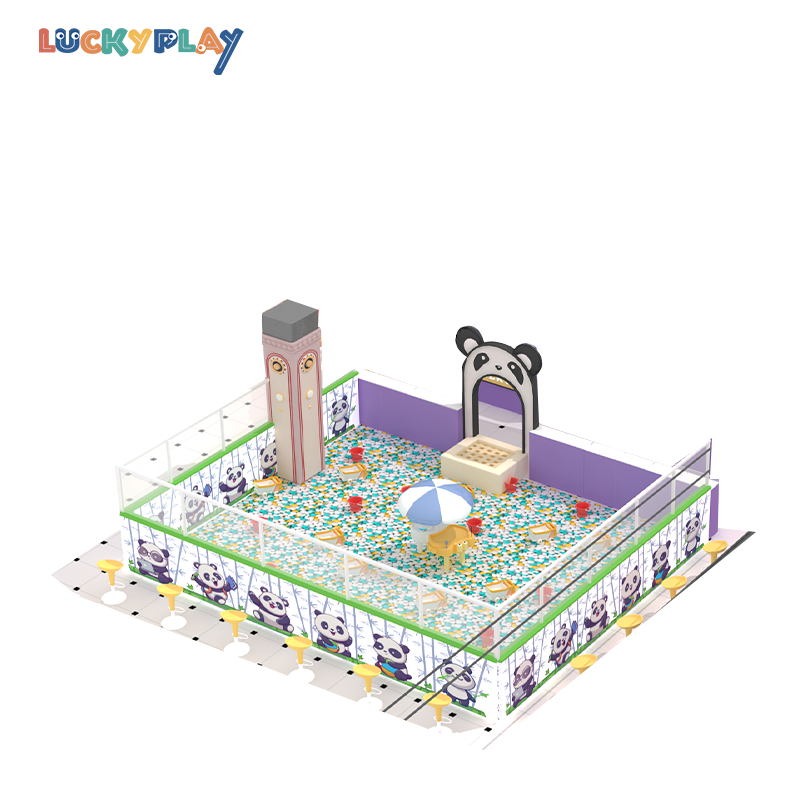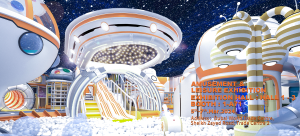Step into a world of wonder and imagination, where laughter fills the air and little ones’ spirits soar. Welcome to the magical realm of indoor play structures! Designed to ignite children’s imaginations, these enchanting playgrounds offer endless hours of fun and exploration. From soaring slides to twisting tunnels, there is something for every child’s adventurous spirit. In this blog post, we will take you on a journey through the evolution of indoor amusement equipment, explore their benefits for children’s development, provide tips on how to choose the perfect structure for your child, and even share creative ways to incorporate them at home. So buckle up and get ready for an exciting adventure into the joy-filled world of indoor play structures!

The Evolution of Indoor Play Structures
Once upon a time, indoor play structures were simple and straightforward. They consisted of basic slides, swings, and climbing frames that provided children with an opportunity to burn off energy and let their imaginations run wild. However, as the years went by, these structures evolved into something truly extraordinary.
In recent times, designers have pushed the boundaries of creativity and innovation to create elaborate play structures that transport children into a world of magic and adventure. From towering jungle gyms that resemble ancient castles to vibrant underwater-themed playgrounds complete with colorful sea creatures, the possibilities are endless.
One key aspect of this evolution is the incorporation of interactive elements. Nowadays, you can find play structures equipped with sensory panels, musical instruments, or even virtual reality games. These additions not only enhance the fun factor but also promote learning through exploration.
Another notable advancement in indoor play structure design is the emphasis on safety features. Manufacturers now prioritize durable materials, non-toxic finishes, soft padding on floors and walls for cushioning falls, as well as rounded edges to minimize any potential hazards.
Types of Indoor Play Structures: From Basic to Elaborate
Indoor play structures come in a wide variety of types, ranging from basic to elaborate designs that can spark the imagination and delight of children. Whether you’re looking for a simple climbing frame or an intricate maze-like structure, there’s something out there to suit every child’s interests and abilities.
Basic indoor play structures often feature elements like slides, tunnels, and climbing walls. These provide opportunities for physical activity while also encouraging imaginative play as children navigate their way through various obstacles. They are perfect for younger kids who are just starting to explore the exciting world of indoor play.
On the other end of the spectrum, elaborate indoor play structures can resemble mini-adventure parks with multiple levels, interactive features, and themed areas. Think pirate ships with rope bridges and hidden treasure or fairy tale castles complete with secret passages and winding staircases. These more complex structures offer endless possibilities for exploration and pretend-play scenarios.
Some indoor play structures even incorporate educational elements such as sensory activities or puzzles designed to enhance cognitive development while having fun. By engaging different senses and challenging problem-solving skills, these advanced designs promote learning through hands-on experiences.
When choosing an indoor play structure for your child, consider factors such as their age, interests, and physical abilities. It’s important to find a balance between providing enough challenge to keep them engaged without overwhelming them.
Remember that safety should always be a top priority when selecting an indoor play structure. Look for products that meet safety standards and have features like soft padding or rounded edges to prevent injuries during active play sessions.
By introducing your child to various types of indoor play structures at home or in dedicated venues like playgrounds or family entertainment centers , you can create opportunities for them to develop key skills while having loads of fun! So go ahead – let their imaginations run wild as they embark on joyful journeys within these magical worlds!

Benefits of Indoor amusement equipment for Children
Indoor play structures offer a wide range of benefits for children that go beyond just providing entertainment. These engaging and interactive environments provide numerous opportunities for physical, cognitive, and social development.
Indoor play structures encourage physical activity. With features like climbing walls, slides, and tunnels, children can engage in active play that helps to improve their coordination, balance, and gross motor skills. This is especially important in today’s technology-driven world where sedentary lifestyles are becoming increasingly common.
Indoor play structures promote imaginative and creative play. By exploring different areas of the structure such as a pretend kitchen or a make-believe castle, children have the opportunity to use their imagination and develop storytelling skills. This type of play fosters creativity and allows children to express themselves freely.
Furthermore, indoor play structures facilitate social interaction among children. Whether it’s playing together on a mini obstacle course or taking turns on a swing set, these spaces encourage cooperation and communication between peers. Children learn valuable social skills such as sharing, compromising, problem-solving while having fun with others.
How to Choose the Right Indoor Play Structure for Your Child
Choosing the right indoor play structure for your child can be an exciting and important decision. With so many options available, it’s essential to consider a few key factors before making your selection.
Think about your child’s age and developmental stage. Younger children may benefit from simpler structures with soft padding and low heights, while older children might enjoy more complex designs with climbing walls or slides. Consider their physical abilities and interests when deciding on the features that will engage them the most.
Next, take into account the available space in your home. Measure the area where you plan to set up the play structure to ensure it will fit comfortably without causing any obstructions. Additionally, consider whether you want a freestanding structure or one that can be attached to an existing wall.
Safety is of utmost importance when choosing an indoor play structure. Look for products that meet safety standards and have been tested for durability. Check for features like rounded edges, secure attachments, and non-slip surfaces to minimize potential accidents.
Don’t forget about aesthetics! Choose a design that complements your home decor and reflects your child’s personality. Bright colors and fun themes can add excitement to any room while creating a visually appealing environment.
By considering these factors – age appropriateness, available space, safety measures, and aesthetic appeal – you can make an informed choice when selecting the perfect indoor play structure for your child’s joyous adventures at home!

Creative Ways to Incorporate Indoor amusement equipment at Home
Indoor play structures are not just limited to commercial spaces or indoor playgrounds. With a little creativity, you can bring the joy and excitement of these structures right into your own home! Here are some creative ways to incorporate indoor play structures at home:
1. Transform a spare room: If you have an extra room that is rarely used, consider turning it into a mini indoor play area. Install a small climbing wall or hang ropes for your child to swing on. Add soft mats or bean bags for safety and comfort.
2. Utilize vertical space: Make use of tall ceilings by installing hanging swings, trapeze bars, or even monkey bars from overhead beams. This will not only provide endless fun but also help improve your child’s motor skills and coordination.
3. Create an obstacle course: Use different pieces of equipment such as tunnels, balance beams, and stepping stones to create an exciting obstacle course in your living room or basement. Encourage your child to navigate through the course using their imagination and problem-solving skills.
4. Build a fort: Combine the concept of an indoor play structure with imaginative play by constructing a fort using blankets, chairs, and pillows. Your child can crawl through tunnels made out of sheets or climb up makeshift ladders leading to their secret hideout.
5. Incorporate sensory elements: Many indoor play structures come with sensory features like slides with textured surfaces or panels with different textures for tactile exploration. Consider adding sensory elements such as sand tables, water tables, or musical instruments within reach of the play structure for added stimulation.
By incorporating these creative ideas into your home environment, you can enhance your child’s physical development while providing them with hours of entertainment right at their fingertips! So go ahead – let their imaginations run wild in their very own magical world filled with endless possibilities!
The Impact of Indoor Play on a Child’s Happiness and Well-being
Indoor play structures have proven to be more than just a source of entertainment for children. They have a profound impact on their happiness and overall well-being. Engaging in physical activities within the safe confines of an indoor play structure not only promotes healthy growth but also contributes to the development of essential skills.
One notable benefit is that indoor play structures provide opportunities for children to enhance their social skills. By interacting with other kids in a fun-filled environment, they learn how to communicate, negotiate, and cooperate effectively. These experiences foster empathy, teamwork, and conflict resolution abilities that are crucial for building strong relationships throughout life.
Additionally, playing on these structures helps children develop gross motor skills such as balance, coordination, strength, and agility. Climbing up ladders or navigating through tunnels requires them to engage different muscle groups while improving their spatial awareness. The physical challenges presented by indoor play structures stimulate both body and mind, contributing positively to a child’s overall physical fitness.
Furthermore, engaging in imaginative play within an indoor play structure allows children to express themselves creatively. Whether they’re pretending to be astronauts exploring outer space or princesses ruling over magical kingdoms – the possibilities are endless! This type of pretend-play encourages problem-solving skills as children navigate imaginary scenarios independently or collaboratively with others.
Indoor play structures also serve as valuable outlets for releasing energy during inclement weather when outdoor activities might not be possible. Instead of feeling bored or restless indoors due to unfavorable conditions outside, children can enjoy active playtime that keeps them engaged physically and mentally.
In today’s digital age where screen time often dominates leisure activities among youngsters, having access to an indoor play structure offers parents an alternative way to keep their kids entertained without relying solely on technology-based pastimes. It encourages them to disconnect from screens temporarily while fostering real-life interactions and experiences.







